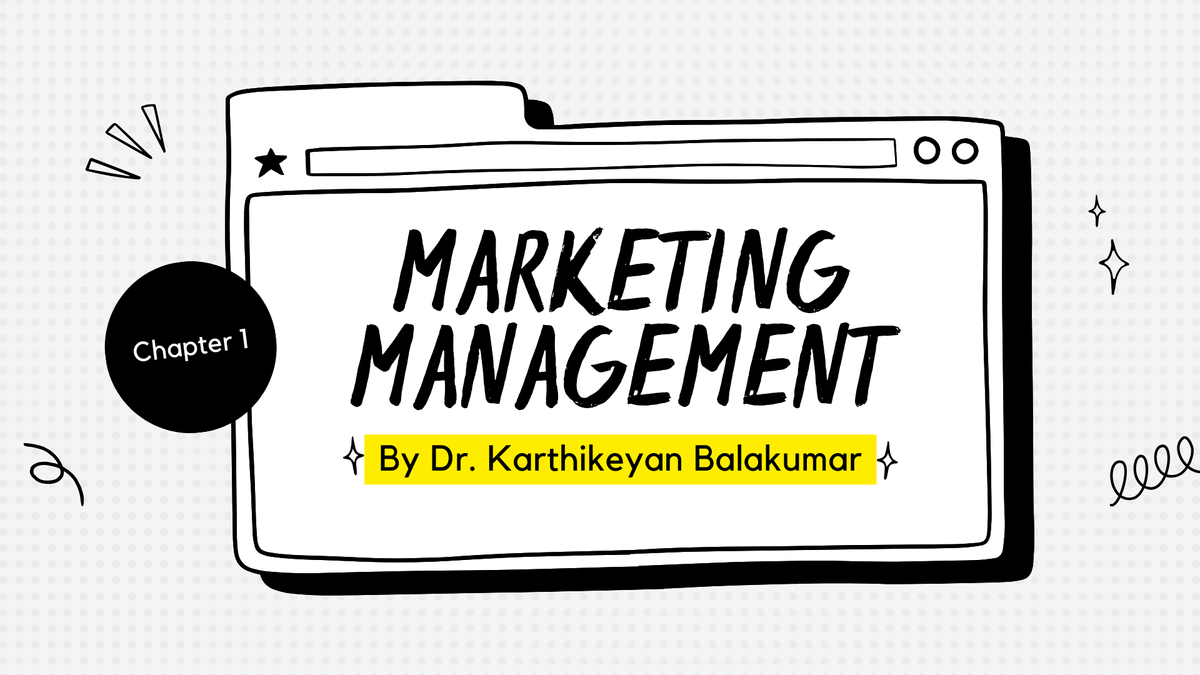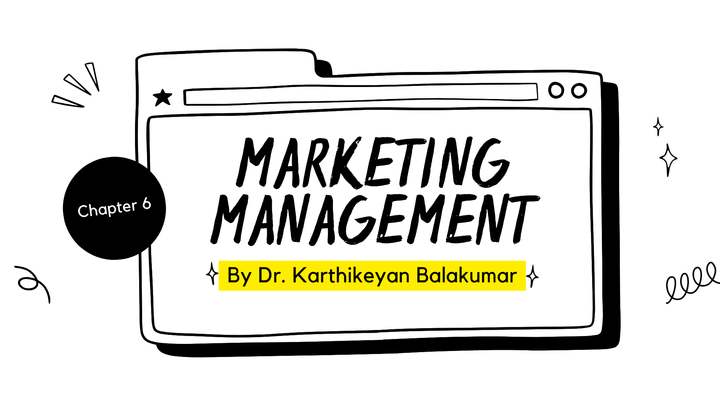Our session on - What is marketing?

IIM Sirmaur was not my first teaching stint. I had worked in a private university (DY Patil University in Navi Mumbai) before this and the students there were the first I had ever taught. Quite understandably, I was (and am still) quite fond of them. When I had left the place to move to Himachal Pradesh one year later, I started missing them. Many of them wrote to me, and spoke to me telling me how they missed my classes. I did not want them to feel left out and the love for students is something every teacher will take seriously. After a little bit of back and forth, it was decided that every time I teach a course here, I would write to them about the key learnings in the classes. Let’s say I was more than happy to copy a great idea that Nehru came up with. Teaching through letters!

Over time, I started realizing that writing and sharing the thoughts help students assimilate more than earlier. Furthermore, it was now possible for me to bridge the gap between two classes. Let me expand on that. Very often, teachers are more active in the first section that they teach, but more articulate in the second section. This starts making us feel that we are not giving the ‘exact’ same inputs to both classes. A letter that talks about the ideas discussed begins to bridge this critical gap. I soon realized that this was something I enjoyed, and also felt duty bound to write. Today, 100+ articles later, many of my friends have been recommending that I compile the writing and publish it as a book. Some have even suggested that I continue doing the same for a few more years and then use the text as a course reader and do away with textbooks that no one really touches until it is exam time. Whatever be the case, these ideas seem to suggest that whenever we do things for the right reasons, good things begin to happen. Over the last year, the readership for the site has increased manifold. I am told that students from other colleges also pick it up and read these articles. Thankfully, the courses that I teach are mainstream and are taught with similar temporal characteristics. Hence it’s easy for them to relate and quite relevant at the time they relate to it too.
“There is no love without the sacrifice of self” - Tagore
Continuing in this tradition, I’ve decided that this year too I will continue writing for each of the classes. It does take a lot of time, and it is difficult to find such time especially considering that I am the placement chairperson here at IIM Sirmaur and also serve in various other committees in different capacities. Coupled with the fact that our institute is also in a nascent campus with a lot of moving parts, the task is even more difficult to accomplish. But then, as Tagore said, “There is no love without the sacrifice of self” and there is truly no love that surpasses the love that a teacher has for his/her students.
So I hope you learn from these letters, and I hope that you use them to become critical, thinking people who will add value to the world at large.
Chapter 1 - Introduction to core concepts
I’m calling what we cover in two sessions as a Chapter for the time being
In this chapter, we will delve into the fundamental principles that underpin the field of marketing. These core concepts will provide a solid foundation for our exploration of more advanced topics in subsequent chapters. But then, before we begin, it’s important that we come to a common definition of what Marketing is. For a long time, the American Marketing Association has taken it upon itself to define what marketing is. Currently, it defines marketing as “the activity, set of institutions, and processes for creating, communicating, delivering, and exchanging offerings that have value for customers, clients, partners, and society at large.” However, it is important that you understand this in a certain context. AMA has been holding conferences for over 50 years now and has been constantly updating the definition of our beloved subject. Here are a list of the past definitions - and I’m sure going through them alone will paint an interesting picture in your minds.
Marketing is he activity, set of institutions, and processes for creating, communicating, delivering, and exchanging offerings that have value for customers, clients, partners, and society at large.
In 1935, it marketing was defined as “the performance of business activities that direct the flow of goods and services from producers to consumers.”
In 1985, this was revised to “the process of planning and executing the conception, pricing, promotion, and distribution of ideas, goods and services to create exchanges that satisfy individual and organizational objectives.”
In 2004, the AMA’s defined marketing as “an organizational function and a set of processes for creating, communicating, and delivering value to customers and for managing customer relationships in ways that benefit the organization and its stakeholders.”
In 2007, this changed to “the activity, set of institutions, and processes for creating, communicating, delivering, and exchanging offerings that have value for customers, clients, partners, and society at large.”.
You see what I am getting at here. The evolution of marketing definitions over time is a reflection of the changing business environment and the expanding role of marketing in society. Initially, marketing was primarily concerned with the efficient distribution of products. However, as markets became more competitive and consumer preferences more sophisticated, the focus shifted towards understanding and meeting customer needs more effectively.
The increasing importance of customer relationships and the recognition that marketing is not just about selling products but also about creating value and building long-term connections necessitated a broader and more inclusive definition. The integration of digital technologies, globalization, and the rise of social media have further transformed marketing into a dynamic and multifaceted discipline.
Also, the modern definitions recognize the impact of marketing on various stakeholders, including society at large, highlighting the ethical and social responsibilities of marketers. This broader perspective ensures that marketing practices are sustainable and beneficial to all parties involved.
It’s about understanding customer needs, creating meaningful connections, and building long-term relationships.
One common misconception is that marketing and sales are synonymous. While both are crucial to a company’s success, they serve different purposes. Sales focuses on the transactional aspect of securing deals and generating revenue. In contrast, marketing is about adding value at every stage of the customer journey, from awareness to loyalty. It’s about understanding customer needs, creating meaningful connections, and building long-term relationships.
If you decide to pick up the Sales and Distribution management course later on in the programme, we will discuss some of these arguments in greater detail.
Now, we have nicely closed this part of the argument. Let’s move to what comes next. A paper that has been almost always the first paper that anyone in a typical MBA course has read over the last 50-60 years - Marketing Myopia.
Marketing Myopia
Theodore Levitt’s influential article “Marketing Myopia” has had a lasting impact on marketing management, emphasizing the importance of a customer-focused approach over production, product, and selling orientations. (I sincerely recommend that you read the whole article if you have not already done so). Levitt’s insights continue to resonate, encouraging businesses to adapt to evolving customer needs for sustained growth and competitiveness.

I’m summarizing some of the key Insights from the article below- just so that you can recount some of the discussions/debates that we had in class.
- Customer Focus: Levitt urged businesses to define themselves as customer-focused entities. This shift promotes continuous innovation and adaptability, ensuring long-term success.
- Adapting to Change: The business landscape has transformed drastically with technological advancements. Firms must integrate customer focus, technology, and dynamic capabilities to remain relevant.
- Holistic Marketing Orientation: Modern businesses should view production, product, and selling orientations as interconnected strategies within a comprehensive marketing approach.
Having said that it is important to recognize that for every story that is ever told, there are several stories that are not told. And much of the learnings that we have in post graduate education are from asking - what are those stories?
Dr. Urvashi Rathod and I have been writing a rejoinder to the original article and have touched up on various moder ideas that we think are important for students to understand. You will find the ideas listed below:
- Jobs to be Done: This theory emphasizes understanding what customers want to accomplish in specific situations, allowing firms to innovate and address both explicit and hidden customer needs.
- Co-Creation: Engaging customers in value creation through collaboration at various stages enhances customer loyalty and provides deeper market insights.
- Sustainability: Businesses must integrate sustainable practices into their core operations to align with consumer preferences and avoid the pitfalls of focusing solely on traditional strategies.
- Technology Push: Innovation driven by technology is crucial for maintaining competitive advantage. Firms need to balance technological advancements with market demand.
- Organizational Agility: Dynamic capabilities enable firms to sense, seize, and transform in response to market changes, ensuring agility and resilience.
In addition to these concepts, we also discussed in class the example of the US Music industry. You can find access to the same dataset here. You should have a look at the data yourself. But then, to cut the long story short, let’s look at each of the eras.
Long Play/Extended Play Era (1970s-1980s): In the 1970s, the music industry experienced a significant boom with Long Play (LP) and Extended Play (EP) records. Sales data from this period showed a sharp upward trajectory, reflecting the popularity of these physical formats. Businesses in the music industry, focused on the success of LPs and EPs, might have been tempted to believe that this trend would continue indefinitely.
Emergence of Cassettes and CDs (1980s-1990s): As technology advanced, cassettes and compact discs (CDs) emerged, offering more convenience and higher sound quality. These new formats quickly gained popularity, leading to a decline in LP and EP sales. The industry adapted by shifting focus to producing and marketing cassettes and CDs, demonstrating a responsive approach to changing consumer preferences.
Rise of Digital Downloads (2000s): The advent of the internet and digital technology introduced downloadable singles and albums. This period saw a significant transformation in how music was consumed, with digital downloads gradually overtaking physical formats. Companies that recognized and adapted to this shift early on were able to capitalize on the new market opportunities.
Streaming Era (2010s-Present): The latest evolution in the music industry is the rise of streaming services like Spotify, Apple Music, and Amazon Music. Streaming has become the dominant mode of music consumption, offering users instant access to vast libraries of music for a subscription fee. This shift has profoundly changed the revenue model for the industry, moving from individual album sales to recurring revenue from subscriptions.
So, what are the lessons that we can take from here:
Avoiding Myopia: The evolution of the US music industry highlights the dangers of a myopic view. Companies that focused narrowly on their current successful formats (e.g., LPs, cassettes, CDs) without anticipating technological advancements and changing consumer behaviors risked obsolescence.
Broadening the Scope: To avoid marketing myopia, businesses in the music industry needed to continually reassess their market definition. Rather than seeing themselves solely as producers of physical music formats, they had to recognize their role in the broader entertainment landscape and adapt to new technologies and consumer preferences.
Strategic Adaptation: The ability to pivot and adapt to new formats—cassettes, CDs, digital downloads, and streaming—illustrates the importance of maintaining a flexible and forward-looking approach. This strategic adaptation allowed companies to stay relevant and profitable amid rapid technological changes.
As a simple thought experiment, you should also look at the examples of Tesla (and how it aligns production efficiency, product excellence, and innovative selling practices to deliver superior customer value), and Toyota (and their cautious approach to electric vehicles highlights the balance between product-oriented and customer-oriented strategies).
These examples will quickly help you understand how Levitt’s notion of Marketing Myopia remains highly relevant, demanding a holistic approach that incorporates customer focus, technological innovation, and sustainability. By understanding and applying these principles, businesses can avoid strategic pitfalls and achieve long-term success.
A quick side note: After watching quite a few of you in suits yesterday in the afternoon, I’m given to understand that you had to make a presentation on Marketing Myopia to your seniors. I hope that some of the ideas that we discussed in class were helpful, and could make you confident of the key ideas that the author tries to talk about. I look forward to hearing about your experiences during the presentation soon!
See you in class soon!



